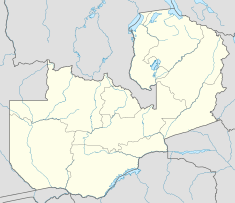Itezhi-Tezhi Dam
| Itezhi-Tezhi Dam | |
|---|---|
 | |
| Location | Itezhi-Tezhi, Zambia |
| Coordinates | 15°45′55″S 26°01′05″E / 15.76528°S 26.01806°ECoordinates: 15°45′55″S 26°01′05″E / 15.76528°S 26.01806°E |
| Construction began | 1974 |
| Opening date | 1977 (hydroelettric plant 2013) |
| Construction cost | 275,000,000 US$ |
| Dam and spillways | |
| Impounds | Kafue River |
| Length | 1.8 km (1.1 mi) |
| Height | 62 m (203 ft) |
| Power station | |
| Turbines | 2 × 60MW |
| Installed capacity | 120 MW |
The Itezhi-Tezhi Dam on the Kafue River in west-central Zambia was built between 1974 and 1977 at the Itezhi-Tezhi Gap, in a range of hills through which the river had eroded a narrow valley, leading to the broad expanse of the wetlands known as the Kafue Flats. The town of Itezhi-Tezhi rests to the north side of the dam.
Dimensions and purpose
The dam has a height of 62 m, a crest length of 1800 m and forms a reservoir of 390 km², which flooded a section of the Kafue National Park.
The initial purpose of the dam is to store water for the hydroelectric power station of the Kafue Gorge Dam more than 260 km downstream. The Kafue River, like most in south-central Africa, has a very high seasonal variation, flooding in the rainy season and slowing to perhaps a twentieth of the peak flow rate at the end of the dry season. Power generation however requires a steady flow, which can only be achieved by having a reservoir large enough to store the rainy season flood for use in the dry season. At the Kafue Gorge the topography does not allow a large enough reservoir to form. The designers of the dam therefore had the idea of siting the main reservoir at Itezhi-Tezhi, and releasing the water in a steady flow down the river along the Kafue Flats to the Kafue Gorge Dam.[2]
Power station
The Zambian power company ZESCO is in the process of building a power station at the dam. The capacity of the station is planned to be 120 MW generated by two machines, costs are estimated to US$ 275-million and construction should be completed by 2013.[3]
Environmental impact of the dam on the Kafue River Flats

The Kafue Flats ecosystem has evolved in response to the conditions of the dam's influence; to regular extremes of flooding and drying out. The floods charge the soil with water. Fish, and animals adapt to swim or wade, help spread nutrients, and when the waters recede, grasses grow rapidly and sustain herbivores such as buffalo, lechwe, and cattle. The natural seasonal cycle has maintained plants, fish, and animals, as they have adapted to the March–April inundation in their nutrition and breeding. Many of the local residents move their settlements annually to cope with the regular cycle of flooding.[4]
The dam removes the peak of the flooding and the trough of low water in the dry season. It reduces the natural seasonal variation of the river flow.[5] The designers intended for the dam to 'open the floodgates' for the duration of March, and allow a flow of 300 m³/s to flood the Kafue Flats in order to maintain natural cycles. However, this has not happened in practice, mainly because the reservoir has not contained sufficient water at the right times to facilitate such a flow. The demand for electric power takes priority, and this, compounded by erratic rainfall since 1990, has prevented the dam from releasing water at the originally intended flow rates.
The Itezhi-Tezhi Dam has impacted the local ecology of the Kafue Flats in the following ways:[4]
- Fish production has significantly declined;
- Wildlife, such as Lechwe, and Sitatunga, which rely on particular timing and extent of the floods in their breeding grounds, have had their breeding behaviour disrupted, leading to population decline;
- In the dry season the amount of grass for grazing has reduced for both wildlife and cattle, and woody species are invading grasslands on the floodplain;
- There is uncertainty of the timing of flooding, and this disturbs traditional human settlements.
The 2003/4 rainy season saw particularly high rainfall in Zambia. The effect of the Itezhi-Tezhi Dam release during this season is shown in the above NASA photos. According to a NASA website, in June 2004 an agreement was made with the hydroelectricity company to restore water releases from the dams according to a more natural flooding regime, prsumably by keeping to the original intention of a 300 m³/s flood for the whole of March.[1]
References
- ↑ 1.0 1.1 NASA Visible Earth website: “Floodwaters Renew Zambia’s Kafue Wetland” Accessed 5 March 2007.
- ↑ Zesco: “History of Itezhi-Tezhi” website accessed 1 March 2007.
- ↑ "DBSA provides $105m for Zambia hydropower expansion". Cramer Media's Engineering News. 2010-11-05. Retrieved 2010-11-17.
- ↑ 4.0 4.1 American Association for the Advancement of Science website: H N. Weza Chabwela & Wanga Mumba, “Integrating Water Conservation and Population Strategies on the Kafue Flats”, Report of a Workshop on Water and Population Dynamics, Montreal, Canada, October 1996.
- ↑ FAO Fisheries Dept: “Status of fish stocks and fisheries of thirteen medium-sized African reservoirs” Website accessed 1 March 2007.